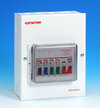It has been a problem since we joined the EU that rest of Europe still use the old 15 amp radial system which became 16 amp as we moved to MCB's. Pre war we also had rows of 15 amp fuses, but our ring final system has always been 3 kW limit, and there are no easy ways to get over 3 kW without a dedicated supply.
With my mothers kitchen the installer used a mini consumer unit in the kitchen, with RCBO's. But as a manufacturer of installed equipment they can stipulate fuses, only had it commercially, not seen any domestic appliance stipulate a fuse, fitting semi-conductor fuses they will open faster than a MCB with a short circuit, and I have seen them stipulated with equipment using solid state relays, but never seen it with domestic appliances.
The regulations have said
[SIZE=4]APPENDIX 15 (Informative)[/SIZE] said:
The load current in any part of the circuit should be unlikely to exceed for long periods the current-carrying capacity of the cable (Regulation 433.1.5 refers). This can generally be achieved by:
(i) locating socket-outlets to provide reasonable sharing of the load around the ring
(ii) not supplying immersion heaters, comprehensive electric space heating or loads of a similar profile from the ring circuit
(iii) connecting cookers, ovens and hobs with a rated power exceeding 2 kW on their own dedicated radial circuit
(iv) taking account of the total floor area being served. (Historically, limit of 100 m² has been adopted.)
this would mean if followed the washer/dryer should also be on a dedicated circuit, as not intended to be moved and over 2 kW, if we tried to follow this many homes would need major work done to bring in the supply.
So we need to use some common sense. Personally I would select different products, the 32 amp supply to cookers has been standard in this country for years, and if a cooker be it oven or hot plate needs a supply lower than 32 amp the fuse or other overload should be built into the appliance. You can get flush consumer units

but they still look ugly, my mother had something like this

on the wall in the kitchen, it looked ugly, but we had little option, dad said "I am not living in a building site, you can rewire the house when I have gone." so SWA cable was taken around the outside of the house to supply the kitchen as the existing rubber insulated wiring was in such a state, house was rewired after he died. But the kitchen consumer unit remained, it was supplied from a 45 amp MCB in the main consumer unit.
I have the consumer unit in this house in the back kitchen, but inside a wooden cupboard so not obvious what it is, together with the DNO meter and fuse, but the back kitchen is only used when having a BBQ, in the main all cooking is done in the front kitchen.
The wiring in my own house is not ideal, the utility room supplying the washing machine and tumble dryer was a problem due to loading, now with a heat pump dryer the load is only 400 watt, so not so much of a problem, but hot fill washing machines are no longer around, so water has to be electrically heated, rather than with the oil and central heating boiler, so nearly all homes have problems due to this ecology drive.
But who ever fits it has to raise a minor works certificate and so not easy to get around lack of supplies, he has to sign to say he has designed the system, I at one point worked fitting cookers, even back in the 90's we often had to walk away without fitting the cooker, felt sorry for the house holder, but we had to follow the rules, not so bad with electric, but gas rules were so strict, I would say on average 1 in 5 not fitted due to some issue, mainly clearance, cupboards too low was common.



